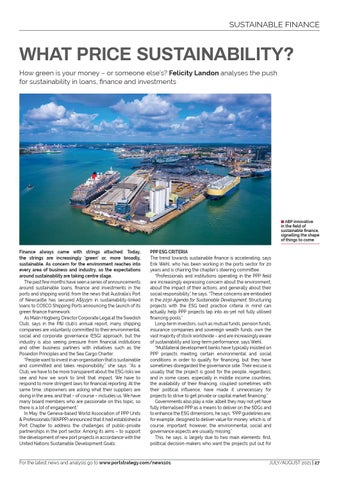SUSTAINABLE FINANCE
WHAT PRICE SUSTAINABILITY? How green is your money – or someone else’s? Felicity Landon analyses the push for sustainability in loans, finance and investments
8 ABP innovative in the field of sustainable finance, signalling the shape of things to come
Finance always came with strings attached. Today, the strings are increasingly ‘green’ or, more broadly, sustainable. As concern for the environment reaches into every area of business and industry, so the expectations around sustainability are taking centre stage. The past few months have seen a series of announcements around sustainable loans, finance and investments in the ports and shipping world, from the news that Australia’s Port of Newcastle has secured A$515m in sustainability-linked loans to COSCO Shipping Ports announcing the launch of its green finance framework. As Malin Högberg, Director Corporate Legal at the Swedish Club, says in the P&I club’s annual report, many shipping companies are voluntarily committed to their environmental, social and corporate governance (ESG) approach, but the industry is also seeing pressure from financial institutions and other business partners with initiatives such as the Poseidon Principles and the Sea Cargo Charter. “People want to invest in an organisation that is sustainable and committed and takes responsibility,” she says. “As a Club, we have to be more transparent about the ESG risks we see and how we work to limit that impact. We have to respond to more stringent laws for financial reporting. At the same time, shipowners are asking what their suppliers are doing in the area, and that – of course – includes us. We have many board members who are passionate on this topic, so there is a lot of engagement.” In May, the Geneva-based World Association of PPP Units & Professionals (WAPPP) announced that it had established a Port Chapter to address the challenges of public-private partnerships in the port sector. Among its aims – to support the development of new port projects in accordance with the United Nations Sustainable Development Goals.
PPP ESG CRITERIA The trend towards sustainable finance is accelerating, says Erik Wehl, who has been working in the ports sector for 20 years and is chairing the chapter’s steering committee. “Professionals and institutions operating in the PPP field are increasingly expressing concern about the environment, about the impact of their actions, and generally about their social responsibility,” he says. “These concerns are embodied in the 2030 Agenda for Sustainable Development. Structuring projects with the ESG best practice criteria in mind can actually help PPP projects tap into as-yet not fully utilised financing pools.” Long-term investors, such as mutual funds, pension funds, insurance companies and sovereign wealth funds, own the vast majority of stock worldwide – and are increasingly aware of sustainability and long-term performance, says Wehl. “Multilateral development banks have typically insisted on PPP projects meeting certain environmental and social conditions in order to qualify for financing, but they have sometimes disregarded the governance side. Their excuse is usually that the project is good for the people, regardless; and in some cases, especially in middle income countries, the availability of their financing, coupled sometimes with their political influence, have made it unnecessary for projects to strive to get private or capital market financing.” Governments also play a role, albeit they may not yet have fully internalised PPP as a means to deliver on the SDGs and to enhance the ESG dimensions, he says. “PPP guidelines are, for example, designed to deliver value for money, which is, of course, important; however, the environmental, social and governance aspects are usually missing.” This, he says, is largely due to two main elements: first, political decision-makers who want the projects put out for
For the latest news and analysis go to www.portstrategy.com/news101
JULY/AUGUST 2021 | 27









